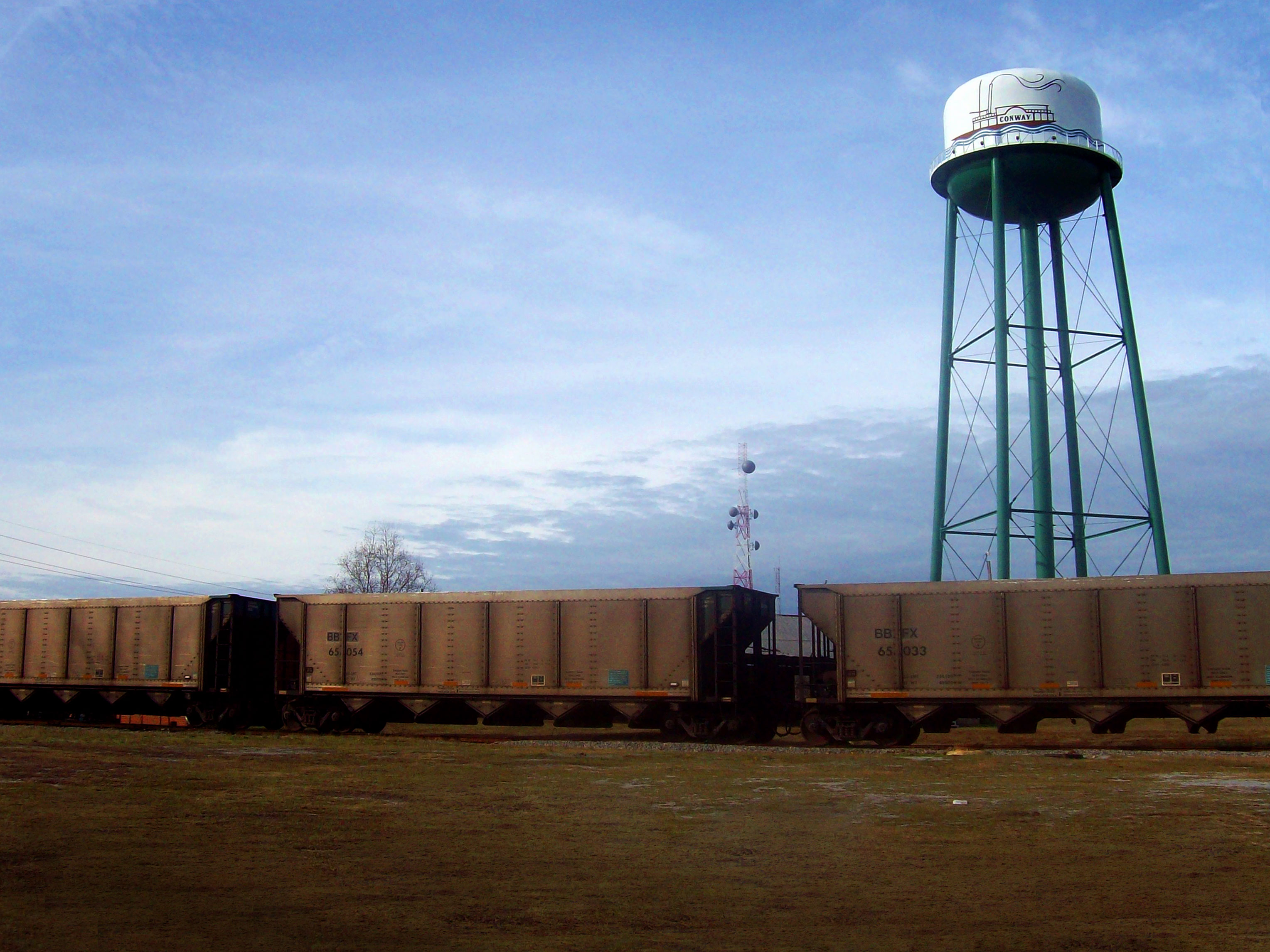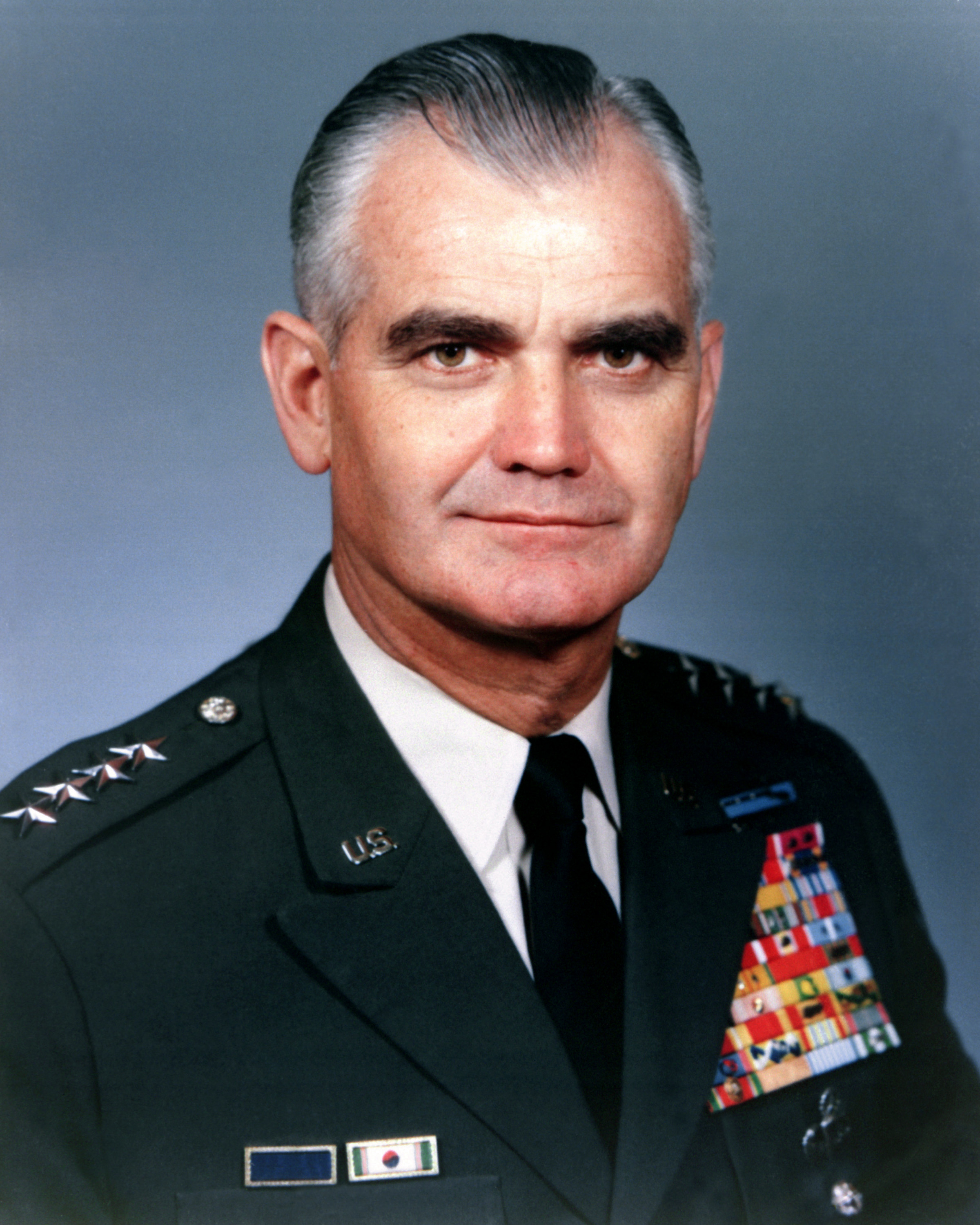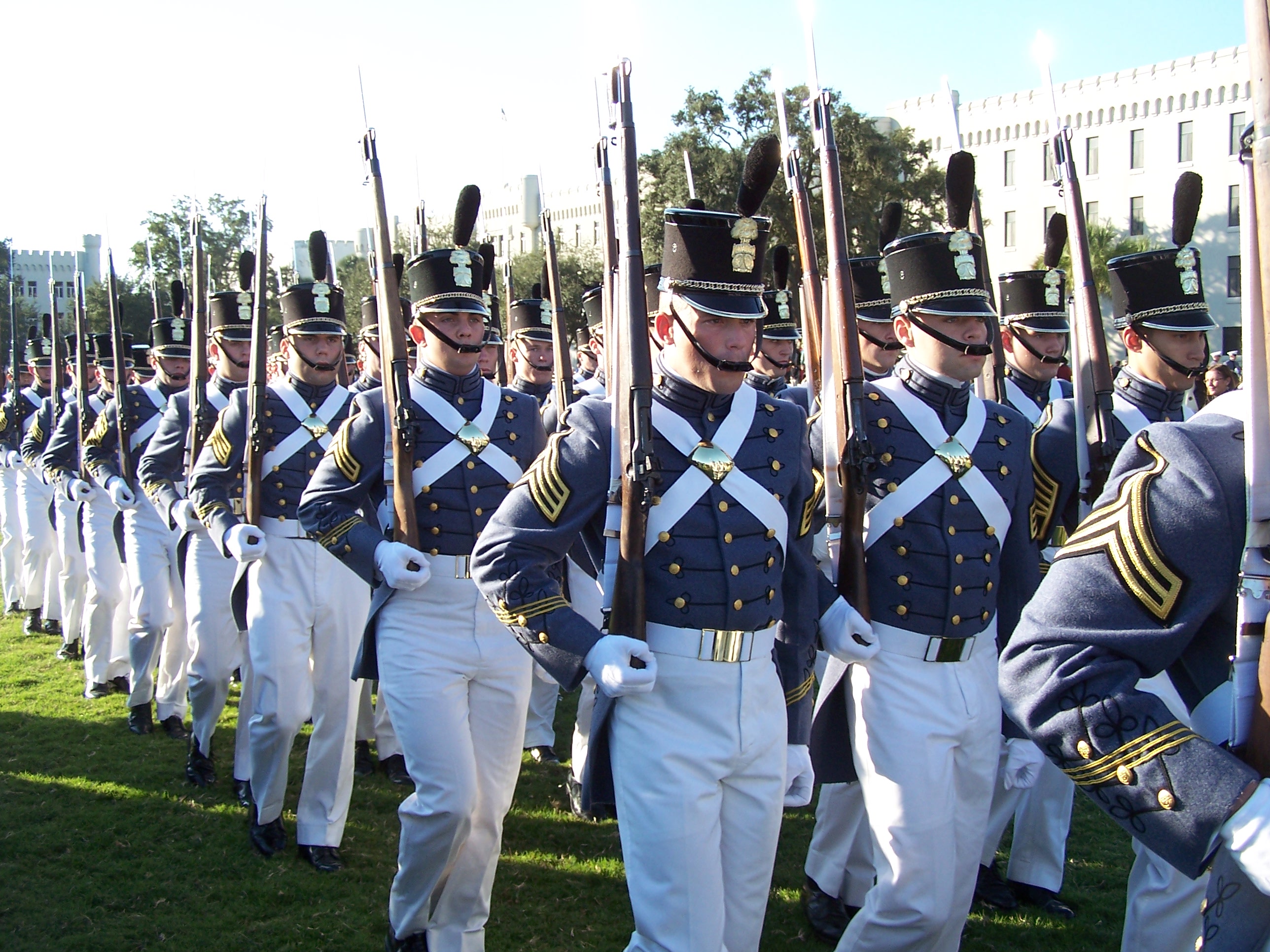|
James B. Vaught
James Benjamin Vaught (November 3, 1926 – September 20, 2013) was a United States Army Lieutenant General who fought in the Korean War and the Vietnam War. In South Korea he served as a company commander in the 24th Infantry Division. In 1967, in South Vietnam, on his first tour he served as the commanding officer of the 5th Battalion, 7th Cavalry. He also played a major role in numerous United States Special Forces operations. He was the overall commander of Operation Eagle Claw, the failed rescue mission of U.S. hostages in Iran in 1980. Early life and military career Vaught grew up in Conway, South Carolina. A multi-generational native of the state, he has been identified as a direct descendant of Francis "Swamp Fox" Marion. However, this is in dispute, as there are no known direct descendants of Marion. He graduated from high school in 1943 and was then enrolled at The Citadel military college in Charleston. During this time, with World War II being fought by Allied ... [...More Info...] [...Related Items...] OR: [Wikipedia] [Google] [Baidu] |
Conway, South Carolina
Conway is a city in Horry County, South Carolina, United States. The population was 24,849 at the 2020 census, up from 17,103 in 2010 census. It is the county seat of Horry County and is part of the Myrtle Beach metropolitan area. It is the home of Coastal Carolina University. Numerous buildings and structures located in Conway are on the National Register of Historic Places. Among these is the City Hall building, designed by Robert Mills, architect of the Washington Monument. Since the completion of the Main Street USA project in the 1980s, Conway's downtown has been revitalized with shops and bistros. Highlighting the renovation of the downtown area is the Riverwalk, an area of restaurants which follows a stretch of the Waccamaw River that winds through Conway. History Conway is one of the oldest towns in South Carolina. Early English colonists named the village "Kings Town" but soon changed it to "Kingston". The town was founded in 1732 as part of Royal Governor Robert J ... [...More Info...] [...Related Items...] OR: [Wikipedia] [Google] [Baidu] |
7th Cavalry Regiment
The 7th Cavalry Regiment is a United States Army cavalry regiment formed in 1866. Its official nickname is "Garryowen", after the Ireland, Irish air "Garryowen (air), Garryowen" that was adopted as its march tune. The regiment participated in some of the largest battles of the Indian Wars, including its famous defeat at the Battle of Little Bighorn, where its commander Lieutenant Colonel George A. Custer was killed. The regiment also committed the Wounded Knee Massacre, where more than 250 men, women and children of the Lakota people, Lakota were killed. The 7th Cavalry became part of the 1st Cavalry Division (United States), 1st Cavalry Division in the 1920s, it went on to fight in the Pacific War, Pacific Theater of World War II and took part in the Admiralty Islands campaign, Admiralty Islands, Battle of Leyte, Leyte and Battle of Luzon, Luzon campaigns. It later participated several key battles of the Korean War. During the Korean War the unit committed the No Gun Ri massa ... [...More Info...] [...Related Items...] OR: [Wikipedia] [Google] [Baidu] |
Khe Sanh Combat Base
Khe Sanh Combat Base (also known as Ta Con) was a United States Marine Corps outpost south of the Vietnamese Demilitarized Zone (DMZ) used during the Vietnam War. History US Army Special Forces (Detachment A-101, Company C, 5th Special Forces Group) constructed a camp with airfield outside the village of Khe Sanh in July 1962. It served as an outpost of the Civilian Irregular Defense Groups. Its purpose was to keep watch on People's Army of Vietnam (PAVN) infiltration along the border and to protect the local population. In January 1966 the People's Army of Vietnam (PAVN) attacked the camp with 120 mm mortars and intelligence indicated that a PAVN buildup was taking place in the area. In March MACV instructed the III Marine Amphibious Force (III MAF) to plan a one-battalion security operation around the camp. On 27 March 3rd Marine Division commander MG Wood B. Kyle ordered the 4th Marine Regiment at Phu Bai Combat Base to deploy the 1st Battalion, 1st Marines and supporti ... [...More Info...] [...Related Items...] OR: [Wikipedia] [Google] [Baidu] |
Battle Of Khe Sanh
The Battle of Khe Sanh (21 January – 9 July 1968) was conducted in the Khe Sanh area of northwestern Quảng Trị Province, Republic of Vietnam (South Vietnam), during the Vietnam War. The main US forces defending Khe Sanh Combat Base (KSCB) were two regiments of the United States Marine Corps supported by elements from the United States Army and the United States Air Force (USAF), as well as a small number of Army of the Republic of Vietnam (ARVN) troops. These were pitted against two to three divisional-size elements of the North Vietnamese People's Army of Vietnam (PAVN). The US command in Saigon initially believed that combat operations around KSCB during 1967 were part of a series of minor PAVN offensives in the border regions. That appraisal was later altered when the PAVN was found to be moving major forces into the area. In response, US forces were built up before the PAVN isolated the Marine base. Once the base came under siege, a series of actions were fought over ... [...More Info...] [...Related Items...] OR: [Wikipedia] [Google] [Baidu] |
Tet Offensive
The Tet Offensive was a major escalation and one of the largest military campaigns of the Vietnam War. It was launched on January 30, 1968 by forces of the Viet Cong (VC) and North Vietnamese People's Army of Vietnam (PAVN) against the forces of the South Vietnamese Army of the Republic of Vietnam (ARVN), the United States Armed Forces and their allies. It was a campaign of surprise attacks against military and civilian command and control centers throughout South Vietnam. The name is the truncated version of the Lunar New Year festival name in Vietnamese, Tết Nguyên Đán, with the offense chosen during a holiday period as most ARVN personnel were on leave. The purpose of the wide-scale offensive by the Hanoi Politburo was to trigger political instability, in a belief that mass armed assault on urban centers would trigger defections and rebellions. The offensive was launched prematurely in the late night hours of 30 January in the I and II Corps Tactical Zones of South V ... [...More Info...] [...Related Items...] OR: [Wikipedia] [Google] [Baidu] |
Battle Of Huế
The Battle of Huế (31 January 1968 – 2 March 1968), also called the Siege of Huế, was a major military engagement in the Tết Offensive launched by North Vietnam and the Việt Cộng during the Vietnam War. After initially losing control of most of Huế and its surroundings, the combined South Vietnamese and American forces gradually recaptured the city over one month of intense fighting. The battle was one of the longest and bloodiest of the war, and the battle negatively affected Opposition to United States involvement in the Vietnam War, American public perception of the war. By the beginning of the North Vietnamese Tet Offensive on 30 January 1968, which coincided with the Vietnamese Tết Lunar New Year, large conventional American forces had been committed to combat operations on Vietnamese soil for almost three years. National Route 1 (Vietnam), Highway 1, passing through the city of Huế, was an important supply line for Army of the Republic of Vietnam (ARVN) ... [...More Info...] [...Related Items...] OR: [Wikipedia] [Google] [Baidu] |
Battalion
A battalion is a military unit, typically consisting of 300 to 1,200 soldiers commanded by a lieutenant colonel, and subdivided into a number of companies (usually each commanded by a major or a captain). In some countries, battalions are exclusively infantry, while in others battalions are unit-level organizations. The word battalion came into the English language in the 16th century from the French language ( French: ''bataillon'' meaning "battle squadron"; Italian: ''battaglione'' meaning the same thing; derived from the Vulgar Latin word ''battalia'' meaning "battle" and from the Latin word ''bauttere'' meaning "to beat" or "to strike"). The first use of the word in English was in the 1580s. Description A battalion comprises two or more primary mission companies which are often of a common type (e.g., infantry, tank, or maintenance), although there are exceptions such as combined arms battalions in the U.S. Army. In addition to the primary mission companies, a battal ... [...More Info...] [...Related Items...] OR: [Wikipedia] [Google] [Baidu] |
Yalu River
The Yalu River, known by Koreans as the Amrok River or Amnok River, is a river on the border between North Korea and China. Together with the Tumen River to its east, and a small portion of Paektu Mountain, the Yalu forms the border between North Korea and China. Its valley became the scene of several military conflicts in the past centuries. Name Two theories are given regarding the origin of the river's name. One theory is that the name derived from ''Yalu ula'' () in the Manchu language. The Manchu word ''yalu'' () means "the boundary between two countries". In Mandarin Chinese, phonetically approximates the original Manchu word, but literally means "duck green", which was said to have been once the color of the river. The other theory is that the river was named after the combination of its two upper branches, which were called "" ( or'' Ap'') and "" ( or ''R''(or ''n'')''ok'')", respectively. Revised Romanization of Korean spelled it (; "Amnok River") and Revised Roma ... [...More Info...] [...Related Items...] OR: [Wikipedia] [Google] [Baidu] |
Busan
Busan (), officially known as is South Korea's most populous city after Seoul, with a population of over 3.4 million inhabitants. Formerly romanized as Pusan, it is the economic, cultural and educational center of southeastern South Korea, with its port being Korea's busiest and the sixth-busiest in the world. The surrounding "Southeastern Maritime Industrial Region" (including Ulsan, South Gyeongsang, Daegu, and some of North Gyeongsang and South Jeolla) is South Korea's largest industrial area. The large volumes of port traffic and urban population in excess of 1 million make Busan a Large-Port metropolis using the Southampton System of Port-City classification . Busan is divided into 15 major administrative districts and a single county, together housing a population of approximately 3.6 million. The full metropolitan area, the Southeastern Maritime Industrial Region, has a population of approximately 8 million. The most densely built-up areas of the city are situated in ... [...More Info...] [...Related Items...] OR: [Wikipedia] [Google] [Baidu] |
West Germany
West Germany is the colloquial term used to indicate the Federal Republic of Germany (FRG; german: Bundesrepublik Deutschland , BRD) between its formation on 23 May 1949 and the German reunification through the accession of East Germany on 3 October 1990. During the Cold War, the western portion of Germany and the associated territory of West Berlin were parts of the Western Bloc. West Germany was formed as a political entity during the Allied occupation of Germany after World War II, established from eleven states formed in the three Allied zones of occupation held by the United States, the United Kingdom, and France. The FRG's provisional capital was the city of Bonn, and the Cold War era country is retrospectively designated as the Bonn Republic. At the onset of the Cold War, Europe was divided between the Western and Eastern blocs. Germany was divided into the two countries. Initially, West Germany claimed an exclusive mandate for all of Germany, representing itself as t ... [...More Info...] [...Related Items...] OR: [Wikipedia] [Google] [Baidu] |
Charleston, South Carolina
Charleston is the largest city in the U.S. state of South Carolina, the county seat of Charleston County, and the principal city in the Charleston–North Charleston metropolitan area. The city lies just south of the geographical midpoint of South Carolina's coastline on Charleston Harbor, an inlet of the Atlantic Ocean formed by the confluence of the Ashley, Cooper, and Wando rivers. Charleston had a population of 150,277 at the 2020 census. The 2020 population of the Charleston metropolitan area, comprising Berkeley, Charleston, and Dorchester counties, was 799,636 residents, the third-largest in the state and the 74th-largest metropolitan statistical area in the United States. Charleston was founded in 1670 as Charles Town, honoring King CharlesII, at Albemarle Point on the west bank of the Ashley River (now Charles Towne Landing) but relocated in 1680 to its present site, which became the fifth-largest city in North America within ten years. It remained unincorpor ... [...More Info...] [...Related Items...] OR: [Wikipedia] [Google] [Baidu] |
The Citadel
The Citadel, The Military College of South Carolina, commonly known simply as The Citadel, is a Public college, public United States senior military college, senior military college in Charleston, South Carolina. Established in 1842, it is one of six senior military colleges in the United States. It has 18 academic departments divided into five schools offering 31 majors and 57 minors. The military program is made up of cadets pursuing bachelor's degrees who live on campus. The non-military programs offer 12 undergraduate degrees, 26 graduate degrees, as well as evening and online programs with seven online graduate degrees, three online undergraduate degrees, and three certificate programs. The South Carolina Corps of Cadets numbers 2,300 and is one of the largest uniformed bodies in the U.S. Approximately 1,350 non-cadet students are enrolled in The Citadel Graduate College, Citadel Graduate College pursuing undergraduate and graduate degrees. Women comprise approximately 9% ... [...More Info...] [...Related Items...] OR: [Wikipedia] [Google] [Baidu] |






